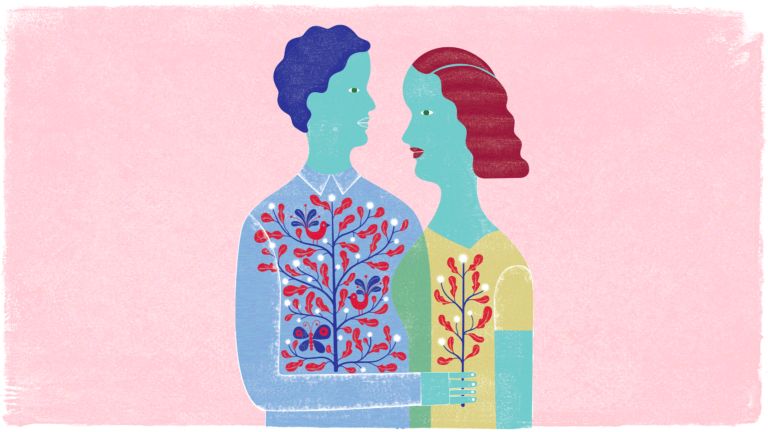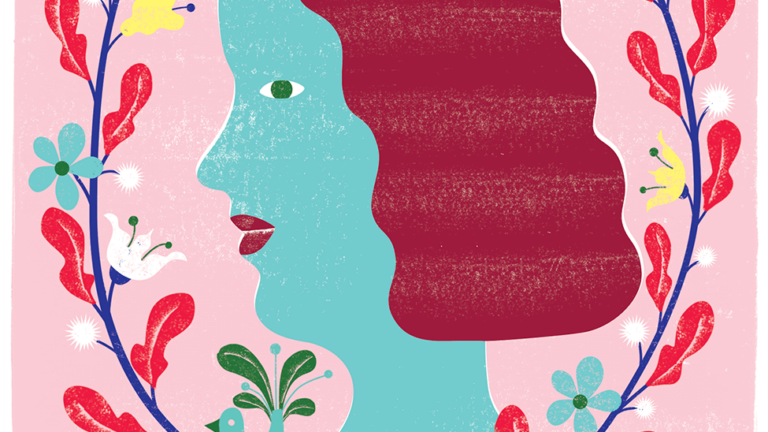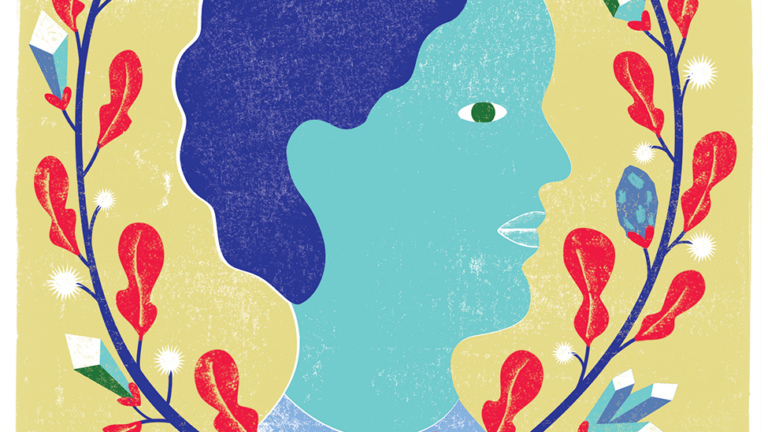Illustration by Melinda Beck
Health
Half match, full life
A transplant method pioneered at USC is making advanced cancer treatment available to all.
Bernadette Nuñez was dating her future husband and making weekend plans when she got sick in May 2018. She had been pulling consecutive 12-hour shifts as a nurse at a small community hospital in the San Gabriel Valley.
“I thought I had gallstones,” Nuñez, 47, recalls of the fatigue and back pain she felt for a couple of days.
A trip to the emergency room proved otherwise.
Within 24 hours, USC doctors diagnosed her with acute lym-phoblastic leukemia (ALL), a type of blood cancer.
“I was in complete denial — I thought they were looking at the wrong medical chart,” recalls Nuñez, who chose to be treated at USC because of her family’s ties to the university. Her mother worked at USC for years as an administrative assistant, and her brother is an alumnus.
ALL, which is most common in children, requires aggressive treatment in adults. Four out of five deaths from ALL occur in adults for a variety of reasons, including the fact that children’s bodies can often handle aggressive treatment better than adults, according to the American Cancer Society.
Because of Nuñez’s age and other factors, oncologists concluded that a bone marrow transplant — also called a stem cell transplant — would eventually be necessary to keep her alive.
Every transplant, of course, requires a donor. For decades, bone marrow transplants were only possible when a “full-match” donor had been found, which means the proteins on the blood-cell surface are completely matched with those of the recipient. Without a full match, the body’s immune system may attack new cells, causing the patient serious complications and hampering their chances for survival. Brothers or sisters have been the most likely match.
Being a Latina reduced the likelihood of Nuñez finding a donor: Because of a lack of Latino donors in the bone marrow registry, the chances of finding full-matched donors are, at best, one out of four.
Thanks to the doctors at the USC Norris Comprehensive Cancer Center, Nuñez was able to beat those odds — without needing a full-match donor.
One of the country’s true pioneers in cancer treatment, USC Norris boasts one of the highest transplant survival rates in the country and began offering bone marrow transplants a decade ago. The center is among the leading institutions for haploidentical — or “half-matched” — transplants. Crucially for Nuñez, children are always a half-match for their parents.
From Half-Match to a Full Life

Nuñez was put in the care of hematologist George Yaghmour, associate director of allogeneic transplant at USC Norris.
From the beginning of her treatment, he knew that Nuñez would need a stem cell transplant.
“At her age, ALL is more challenging because the relapse and mortality rates are high,” he explains.
Studies Yaghmour has conducted show that in the high-risk Latino population, using a half-matched donor is the best option for adult ALL patients like Nuñez.
Since joining Keck Medicine of USC in 2016, Yaghmour — who has aimed to push the boundaries of cancer treatment throughout his career — has performed more than 250 bone marrow transplants. He explains that donor availability varies significantly across differ-ent ethnic groups. This disparity can lead to delays or the inability to undergo potentially life-saving transplants.
“I’m a big advocate for health equity,” he says. “Everybody deserves the best care.”
Risk of Rejection

Nuñez’s son, Andrew Sunda, 26, began looking for a donor as soon as he learned of his mother’s cancer. He set up a campaign to find a full-match donor on an online platform, but none was found.
When the next best option turned out to be a half-match donor, Sunda didn’t hesitate in stepping up to be his mother’s donor.
Haploidentical transplants are a type of allogeneic transplant in which healthy, blood-forming cells from a half-matched donor replace the unhealthy ones; allogeneic transplants are ideal for leu-kemia patients. The family quickly discovered that the USC Norris Comprehensive Cancer Center was the best possible place for this procedure: In January 2023, USC Norris became the first adult allo-geneic transplant center in history to reach a 90% one-year survival rate calculated on a rolling three-year basis.
“That achievement is comparable to breaking the 4-minute-mile running barrier,” says Preet Chaudhary, director of the USC Norris Blood and Marrow Transplant and Cell Therapy Program and chief of the Nohl Division of Hematology and Center for Blood Diseases at the Keck School of Medicine of USC.
Before the transplant, Nuñez underwent total body irradiation, a kind of system reboot that involves radiotherapy to suppress the immune system and reduce the chance of rejection of donor stem cells.
The transplant procedure was scheduled in April 2019; the day before, Sunda was in a patient room a few floors below his mother, preparing to donate his bone marrow.
The process of replacing Nuñez’s bone marrow with her son’s was a two-hour procedure.
Afterward, Sunda visited his mother.
“We made jokes about the transplant,” Sunda says. “I wanted to keep her spirits high.”
In the days and weeks following a transplant, there is always a chance that the person receiving the stem cell transplant will develop graft-versus-host disease, a severe complication that can occur when a donor’s immune system’s white blood cells recognize the recipi-ent’s tissues as foreign.
Fortunately, Nuñez’s body accepted her son’s stem cells, and Sunda recovered quickly from the donation procedure and remains in excellent health.
Just over one year later, Nuñez was able to attend her son’s graduation from his undergraduate program at California State University, Los Angeles, in 2020, where he is now pursuing a master’s degree in geological sciences.
Keeping Positive
Yaghmour says he places a premium on a holistic approach to cancer care, where emotional support is delivered along with the latest, most advanced therapies.
Nuñez says keeping positive throughout her treatment was critical to her recovery. She refused to be seen as a patient, eschewing a hospital gown for street clothes.
“Probably the hardest part of this was seeing what my diagnosis did to my loved ones,” says Nuñez, who will remain on low-dose chemotherapy treatment for the next three years.
Today, Nuñez is back to living a full life. In addition to a job as a nurse case manager, Nuñez is working on getting a college degree and enjoying watching her son flourish in his career as a geologist.
She’s also busy making plans, mapping out a retirement filled with travel alongside her husband, Ryan.
Last summer, the two were planning a vacation in the Big Island of Hawaii.
Healthy Outlooks
The lessons learned from cases like Nuñez’s will be part of Yaghmour’s upcoming book about the power of positivity in a clinical setting.
“It’s important for us to give our cancer patients boosts of good, positive hope and energy because this type of attitude can help them recover,” he says.
It’s a belief Yaghmour came to embrace while growing up in his native Syria and one that has yielded great outcomes for many of his patients mired in the relentless grip of leukemia.
Yaghmour recalls another patient who was on the brink of death; he performed a bone marrow transplant, and the patient healed in time for him to walk his daughter down the aisle on her wedding day.
Yaghmour, who has been honored by the Leukemia & Lymphoma Society for his fundraising efforts, now has performed close to 100 haploidentical bone marrow transplants.
“I always dreamed I would become a person who would make a difference in the world,” he says.
Nuñez and her family are among the many patients at USC Norris who know that he already has.
“I’m forever indebted to Dr. Yaghmour and his team and what they did for my mom,” Sunda says.